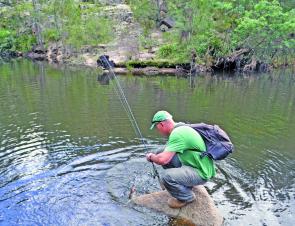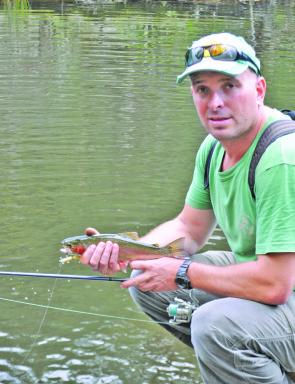From Lithgow to Oberon and just about everywhere in between anglers have undoubtedly experienced one of the best river trout seasons for a decade or longer and while the associated still waters of Lake Oberon, Lake Lyell, Lake Wallace and Thompsons Creek Dam have sustained a reasonable harvest for anglers in previous seasons, it has been the renaissance of the rivers that has drawn many anglers back to the Central Tablelands.
Initial flooding in December 2010 saw just about all dams spilling over without too much destruction of rivers and habitat below. Trout quickly dispersed and whether following floodwater over the spillways or pointing their noses into the smell of the fresh current coming from the headwaters, they fought fin and froth to reach new rich waters.
Lake Wallace was quick to overflow and with further increased inflow, a large amount of silt was brought in and mud was stirred up, causing extremely poor water quality. Add to this large amounts of ribbon weed mixed in with the maelstrom and the fishing was non-existent.
The recovery has remained slow and it must be said that local anglers have their fingers crossed for a better Winter season, which historically has produced the better, more consistent fishing.
Tailrace fishing below Lake Wallace was exemplary. Lure, bait and fly anglers caught a mix of rainbow trout and bass, plus the occasional brown trout.
While some small to middling rainbows moved up into the flow, it was the big rainbow trout and occasional 40cm-plus bass that had been washed over the wall from the main dam that kept anglers at times shoulder to shoulder day and night in the tailrace pool below the spillway and several pools below.
The western-flowing catchment received the most rainfall and while the western dams of Chifley, Wyangala and Burrendong were rising fast and reaching capacity, offering anglers some furious cod and golden perch fishing, it was the inflows into the smaller feeder creeks and rivers that benefited the local trout.
With vastly increased areas to feed and flourish, they quickly put on weight and condition and showed a keenness to chase a lure or fly.
The redfin plague continues to grow in our local watershed with Oberon Dam perhaps the most significant storage hit by the blight. Our hope is that increased stocking of trout and native Murray cod and golden perch will ultimately overcome the redfin numbers and achieve a more harmonious balance of species, be they introduced or native.
Redfin now are declared noxious fish and it is an offence to be found in possession of a live redfin.
Sections of the fish River, indeed most parts perhaps, have recorded redfin in numbers being caught by anglers. Trout in these redfin-progressive areas are still present but the equilibrium is becoming heavily offset.
However, it must be said that the trout are still very much a main target species and with continued stocking they should hold their own against the redfin, especially if high water levels continue during the trout spawning periods.
Brown trout are well suited to our slightly slower western rivers and headwaters in hard, rocky country where shingle and gravel beds abound have proved to be excellent areas for trout breeding.
No doubt due to stocking, rainbow trout have become more prevalent in the Fish River and respond well to all techniques of lure bait or fly, but often it’s the Fish River’s wily brown trout that attract anglers back for another go.
Sustainable stocks of brown trout still flourish throughout the Fish River and natural procreation and stocking by the Lithgow branch of the Central Acclimatisation Society (CAS) have always ensured this.
Whether you are chasing a late Spring brown on a dry fly or flicking a lure into the head of a pool for a hormonal Mr and Mrs Speckles, a Fish River brown trout is always special.
Looking east, and trout have pushed their way up many of the small rivulets that flow from the higher, steeper ground.
The River Lett has had some excellent trout fishing in its narrow waters. Both rainbow and brown trout of many different year groups were caught by anglers throwing small bibbed minnow lures and Mepps-style spinners across some of the pools or up faster flowing rapids and riffles.
The Coxs River between Lake Lyell and Lake Wallace has fished quite well with the increased flows from Wallace but brief intermittent poor water quality produced brief periods when the fish shut down.
Anglers have caught Australian bass in this section of river. Many of these would be escapees from Wallace and but many people hope that, with stocked bass from Lake Lyell moving upstream, this section of river will become a Summer haven for bass and anglers.
Initial increased water levels at Lake Lyell sent the fish troppo with excellent catches of brown and rainbow trout and some brilliant bass fishing. After some weeks the flooded vegetation began to decompose and the oxygen levels dropped significantly enough to cause isolated fish kills and periods of shut-down fish. They could still be found but some searching was required.
With the water levels maintained during Summer and Autumn, the dam stabilised and produced more predictable fishing. With the Winter season now upon us, anglers are hopeful of good times to come.
Thompsons Creek dam has always been popular with fly anglers, who experienced good fishing right through the long drought.
With Lake Lyell full, Delta Electricity was quick to start pumping back up the hill to increase the dwindling capacity of Thompsons Creek Dam.
Although still not at maximum capacity, TCD Dam’s islands disappeared, large flats submerged and the plunging depths of quarries were filled.
The result has been a complete makeover for the dam. Submerged shrubs, bushes and trees have been in the fishes’ favour.
The large rock-fill wall has always fished well and has continued to be a point of focus with anglers for good reason.
The bottom line is there’s a whole new dam to learn about now, with much of it to be explored by fish as much as fishers.
Trout fishing on the Central Tablelands has, it seems, come full circle and as testimony to the species, their suitability to the extremes of the local climate have bounced back to prominence and with the promise of cool wet winter to further enhance the renaissance of the Central Tablelands trout.
With the increased recovery of trout cod, now being encountered as far as the Macquarie River at Dubbo, and the latest breakthrough in the artificial breeding of Macquarie perch, it seems native fish may be able to make a comeback against the invasive exotics.
That said, there is always likely to be a place for trout in anglers’ hearts – and in the Central Tablelands streams and dams.
Reads: 15653
An angler lands a neat Coxs River rainbow trout. The rocky headwaters of the Coxs and its tributaries have been great locations to chase river rainbows right through the past season.

A typical upper Coxs River rainbow trout. Darren Turner caught this one on a Rapala minnow cast into the head of a small rocky pool.

The author struggles to cope with a marauding Fish River rainbow trout, a common and welcome sight over the past season.

As the water subsided and overflows reduced, further exploration of the flooded areas often revealed plenty of trout.

Searching new backwaters in a canoe is perhaps the best way to fish the reclaimed land in the many bays and arms of Lake Lyell.

Brightly marked fish like this are a pleasure to catch and easy on the eye.0




